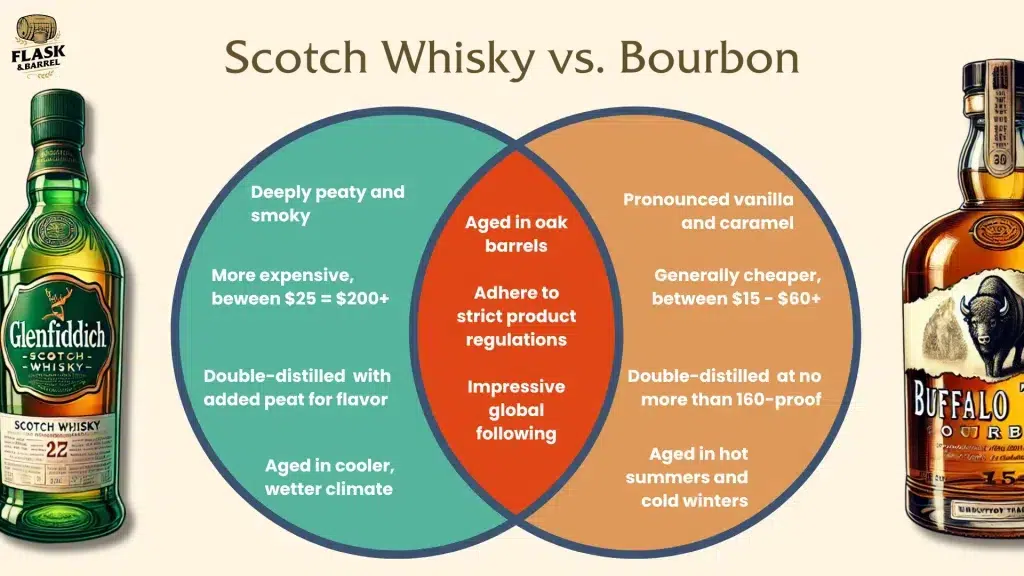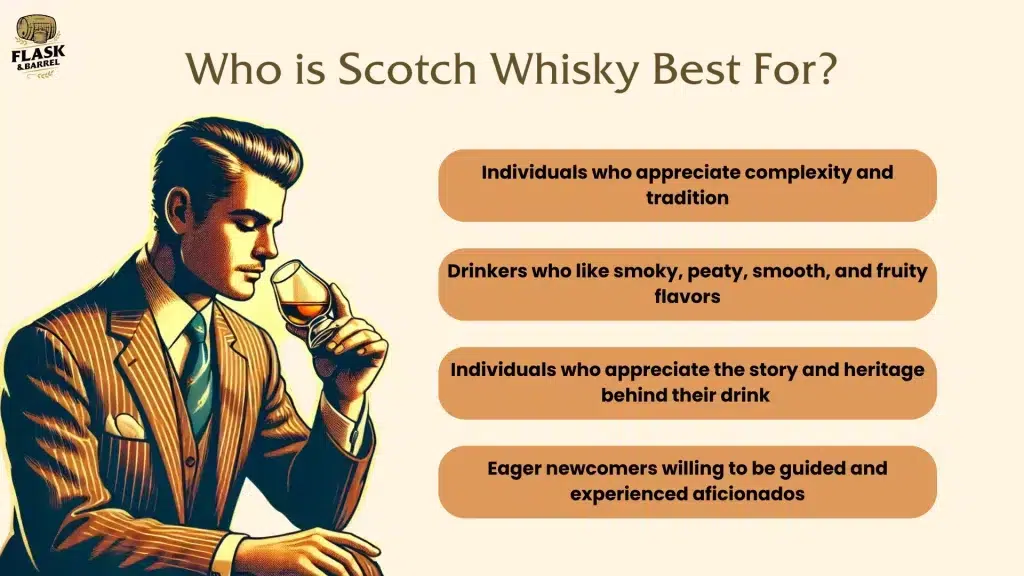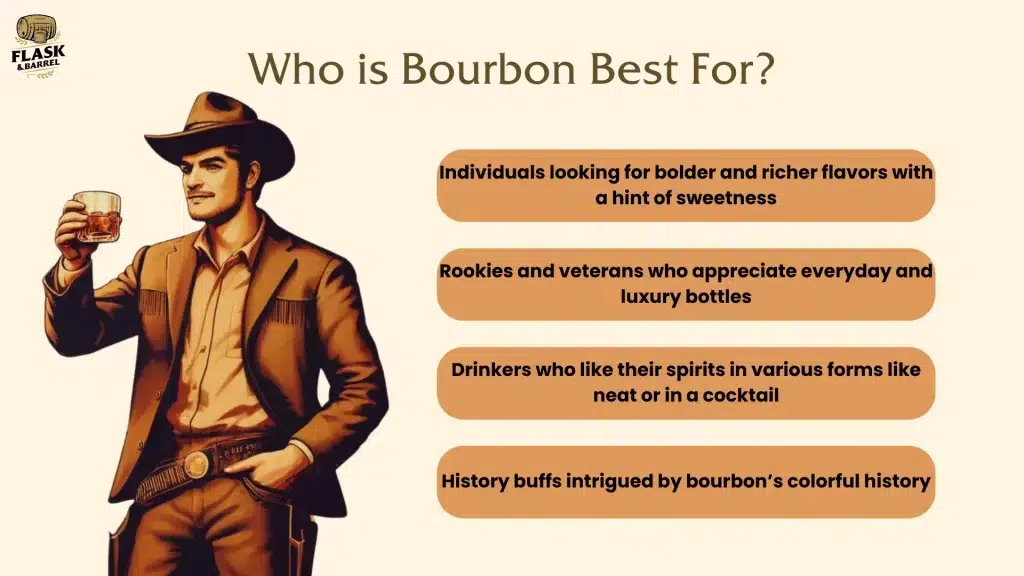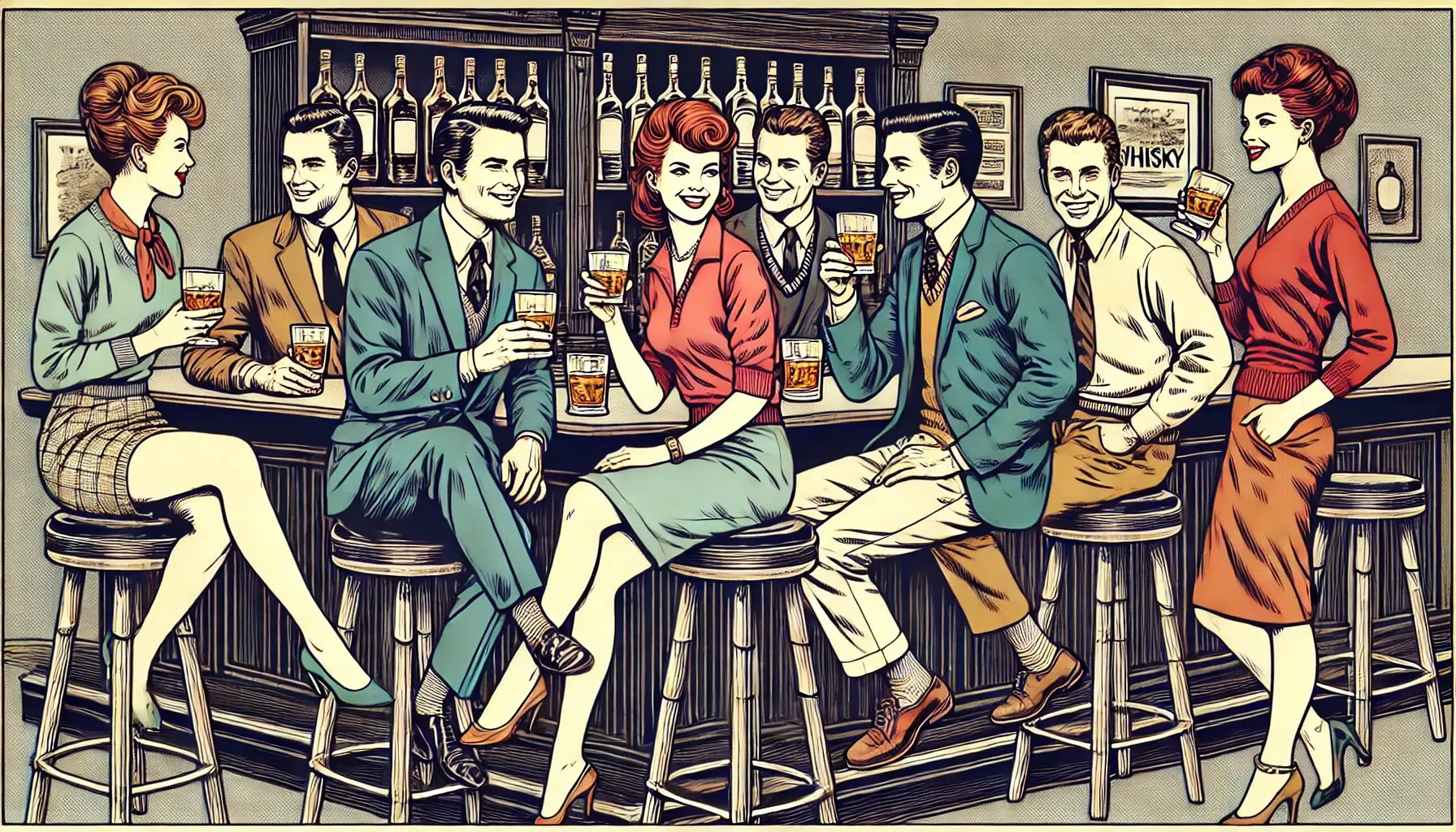Scotch whisky, often considered the grandmaster of whiskey, is renowned for its complexity and rich tradition. With categories like Single Malt, Single Grain, and Blended Scotch, each type offers a unique taste of Scotland’s distilling heritage.
Single Malt Scotch, in particular, is celebrated for capturing the distillery’s distinct water source, fermentation, and regional character. Meanwhile, Bourbon, America’s native spirit, is loved for its bold, sweet profile, thanks to its corn-rich mash bill and new oak barrel aging. This includes Straight Bourbon, with its strict production standards, and Kentucky Bourbon, known for its Southern flair.
Each type of Scotch and Bourbon brings its own flavors and cultural significance, making them more than just drinks—they’re stories. The next sections will dive into what sets Scotch and Bourbon apart.
The Defining Characteristics of Scotch
Scotch whisky is celebrated for its stringent production standards and deep-rooted heritage, which collectively forge the spirit’s unique identity and appeal. Central to its distinction, Scotch must be distilled and aged in Scotland, ensuring its authenticity and intrinsic connection to the Scottish environment. The aging process, a compulsory minimum of three years in oak barrels, endows Scotch with its characteristic depth and complexity.

Further diversifying its profile are categories such as Single Malt, Single Grain, and Blended varieties, each presenting a distinct palate experience. The use of peat in the malting process of certain Scotch whiskies imparts a smoky flavor, emblematic of many iconic Scotch expressions. This intricate melding of location, aging, and production nuances shapes the distinct identity of Scotch whisky, elevating it to a revered status in the spirits world.
To provide readers with a tangible connection to the information presented, here are examples of Scotch brands that exemplify the defining characteristics:
- Single Malt Scotch: Glenfiddich, The Macallan, and Laphroaig are renowned for showcasing the singular expression of their respective distillery’s water source, fermentation process, and regional nuances. Laphroaig, for instance, is famous for its intensely peaty flavor, a hallmark of Islay malts.
- Blended Scotch Whisky: Johnnie Walker, Chivas Regal, and Dewar’s offer a harmonious blend of malt and grain whiskies, demonstrating the artistry of blending to achieve a consistent flavor profile that appeals to a wide range of palates.
- Single Grain Scotch: Though less commonly encountered than single malts or blends, single grain Scotch whiskies like Haig Club and Cameron Brig provide a lighter, often sweeter tasting experience, showcasing the versatility within the Scotch category.
The Defining Characteristics of Bourbon
Bourbon, celebrated as America’s native spirit, is defined by its rich, sweet profile and versatile character, stemming from its distinct production standards. Key to Bourbon’s identity is the requirement that it must be made with at least 51% corn in its mash bill, imparting a signature sweetness. Aging in new, charred oak barrels not only gives Bourbon its deep amber color but also introduces complex flavor notes, such as vanilla and caramel.

Notable examples that showcase Bourbon’s defining characteristics include Buffalo Trace, known for its rich and complex flavor profile, and Maker’s Mark, with its distinctive sweetness and smooth finish. Woodford Reserve stands out for its deep amber color and rich flavor notes, a direct result of meticulous aging in new, charred oak barrels. These brands exemplify the impact of the corn-rich mash bill and the new oak barrel aging process, reinforcing Bourbon’s unique identity.
While there is no minimum aging period to be labeled as Bourbon, to earn the title of Straight Bourbon, it must be aged for at least two years and be free from any added coloring, flavoring, or other spirits. Although Bourbon can be produced throughout the United States, Kentucky is often heralded as its heartland, where the unique climate and natural resources significantly influence the aging process. This blend of corn dominance, barrel specifications, and geographical nuances collectively crafts Bourbon’s distinctive identity, securing its position as a widely cherished spirit.
In What Ways Are They Similar?
Despite their distinctive origins and flavors, Scotch and Bourbon share core similarities that underscore their membership in the broader whiskey family. Both spirits are required to undergo an aging process in oak barrels, a method that imbues them with depth and complexity. They are governed by strict production regulations that safeguard their quality and authenticity, ensuring that each bottle meets the high standards set forth by their respective traditions.
The necessity of distillation is another commonality, serving as a pivotal stage in crafting the initial character of these distinguished spirits. Moreover, Scotch and Bourbon boast a global following, with enthusiasts around the world celebrating their rich histories, cultural significance, and their versatility in consumption — whether enjoyed neat or as the foundation of elaborate cocktails. This shared heritage and commitment to tradition highlight the kinship between Scotch and Bourbon, bridging the gap between their geographical and procedural distinctions.
Popular Culture and Cocktails: Both Scotch and Bourbon have made significant marks in popular culture, often featured in films, literature, and television shows that celebrate or revolve around their rich heritage and nuanced flavors. For instance, Scotch is famously associated with sophisticated characters like James Bond and Ron Swanson from “Parks and Recreation,” symbolizing refinement and depth. Bourbon, with its bold and versatile character, has been celebrated in the American South’s culture and beyond, often associated with classic American cinema and music.

Cocktail Versatility:
- Scotch Cocktails: The Rob Roy, made with Scotch, sweet vermouth, and bitters, showcases Scotch’s versatility beyond neat sipping. The smoky flavors of Scotch also play well in the Penicillin cocktail, which combines lemon, honey, and ginger for a refreshing mix.
- Bourbon Cocktails: The Old Fashioned, arguably one of the most iconic cocktails, highlights Bourbon’s rich sweetness, balanced with bitters and sugar. The Mint Julep, a staple at the Kentucky Derby, showcases Bourbon’s refreshing side when mixed with mint and sugar.
In What Ways Are They Different?
Scotch and Bourbon, while both revered members of the whiskey family, exhibit distinct differences in their ingredients, production processes, and geographical origins. At the heart of their divergence is the base ingredient; Scotch is crafted predominantly from malted barley, imbuing it with a smoky, earthy profile, whereas Bourbon is defined by its corn dominance, resulting in a sweeter, often caramel-infused flavor. The aging requirements further distinguish the two, with Scotch necessitating a minimum of three years in oak barrels — often much longer for premium varieties — compared to Bourbon, which has no minimum aging requirement for its basic classification, though Straight Bourbon must age for at least two years.
Geographically, Scotch’s identity is inseparable from Scotland, its production strictly confined to this region, thus reflecting its unique terroir. Conversely, Bourbon, though closely associated with Kentucky, can be produced anywhere in the United States. These variations in ingredients, aging, and origin not only define their unique characteristics but also contribute to the rich tapestry of the whiskey category, offering diverse sensory experiences to enthusiasts around the globe.
To provide a clearer understanding of the distinctions, here’s a side-by-side comparison of specific Scotch and Bourbon products:
| Feature | Scotch Example: Glenfiddich 12 Year Old | Bourbon Example: Buffalo Trace |
|---|---|---|
| Base Ingredient | Malted Barley | At least 51% Corn |
| Flavor Profile | Notes of pear, butterscotch, and oak | Notes of vanilla, caramel, and spice |
| Aging Requirement | Minimum of 12 years in oak barrels | No minimum, but must be aged in new charred oak barrels; Buffalo Trace is aged for at least 8 years |
| Geographical Origin | Scotland | Kentucky, USA |
| Production Process | Double distillation | Continuous column still distillation |
Comparing Scotch and Bourbon
Comparing Their Flavor
| Flavor Aspect | Scotch Examples | Bourbon Examples |
|---|---|---|
| Smoky/Peaty | Laphroaig 10 Year Old (Islay) | Not typically associated with Bourbon |
| Floral/Fruity | Glenfiddich 12 Year Old (Speyside) | Four Roses Single Barrel |
| Vanilla/Oak | The Macallan Sherry Oak 12 Years Old | Woodford Reserve Distiller’s Select |
| Caramel | Balvenie DoubleWood 12 Year Old | Buffalo Trace |
Comparing Their Price Range
| Price Range | Scotch Examples | Bourbon Examples |
|---|---|---|
| Budget (<$50) | Monkey Shoulder Blended Malt Scotch Whisky | Buffalo Trace Kentucky Straight Bourbon |
| Mid-Range ($50-$100) | Glenlivet 18 Year Old | Blanton’s Single Barrel Bourbon |
| Premium (>$100) | The Macallan 18 Year Old Sherry Oak | Pappy Van Winkle’s Family Reserve 15 Year Old |
Comparing Their Distillation Process
| Distillation Aspect | Scotch Example | Bourbon Example |
|---|---|---|
| Distillation Method | Glenfiddich (Double Distillation) | Maker’s Mark (Continuous Column Still) |
| Aging Process | The Glenlivet 12 (Minimum 3 Years in Oak Barrels) | Eagle Rare 10 Year Old (Minimum 2 Years for Straight Bourbon, often aged longer) |
Comparing Their Popularity
| Year | Scotch Popularity | Bourbon Popularity |
|---|---|---|
| 2015 | Stable, traditional market | Rising, especially craft bourbons |
| 2020 | Gradual increase, focus on premium products | Significant growth, driven by craft and premium products |
| 2023 | Continued interest in aged and rare bottles | Widespread popularity, including international markets |
Comparing Their Critical Acclaim
| Award/Recognition | Scotch Winners | Bourbon Winners |
|---|---|---|
| World Whiskies Awards 2020 | Glenallachie 15 Year Old – Best Scotch | Ironroot Republic Harbinger – Best Bourbon |
| Jim Murray’s Whisky Bible | Glen Grant 18 Year Old Rare Edition – Single Malt of the Year | William Larue Weller 128.2 Proof – Bourbon of the Year |
Who Is Scotch Best For?
Scotch whisky caters to those with an appreciation for complexity and tradition in their spirits. It’s a perfect match for the connoisseur or the curious drinker keen on navigating through a diverse palette of flavors, from the smoky and peaty to the light and floral. Scotch appeals to individuals intrigued by the heritage and craftsmanship of whisky-making, offering a taste of Scotland’s history and terroir with every sip.

Moreover, it holds a special allure for collectors and those who cherish the prestige and variety of aged spirits, presenting a rich selection for both enjoyment and investment. Profiles of Typical Scotch Drinkers:
- The Connoisseur: Enjoys exploring the nuances of different Scotch regions, from the peaty Islay malts to the smooth Speyside whiskies. They appreciate the craftsmanship behind each bottle and often have a collection that showcases the diversity of Scotch whisky.
- The History Buff: Fascinated by the rich history and tradition of Scotch production. They enjoy sipping Scotch while delving into the stories of ancient distilleries and the evolution of whisky-making techniques.
- The Collector: Seeks out rare and aged Scotches, viewing them not only as beverages but as investments. They take pride in acquiring limited edition releases and enjoy the prestige that comes with an extensive and valuable collection.
- The Adventurous Drinker: Always on the lookout for new and unique Scotch expressions. They’re eager to try whiskies from lesser-known distilleries or those with unconventional aging processes.
Scenarios in Which Scotch is Traditionally Enjoyed:
- Tasting Events: Scotch tastings provide an opportunity for enthusiasts to sample a variety of styles and learn about the subtleties of each.
- Special Occasions: Celebrations and milestones often call for a bottle of fine Scotch, shared among friends and family as a toast to the occasion.
- Quiet Evenings: Many Scotch lovers enjoy unwinding with a dram of their favorite malt, savoring the complexity and warmth it offers.
- Pairing Dinners: Scotch can be a wonderful companion to food, with certain whiskies complementing specific dishes, enhancing the dining experience.
Who Is Bourbon Whisky Best For?
Bourbon whisky finds its audience across a spectrum, from casual drinkers to enthusiasts who savor a spirit with a rich, sweet profile. Its approachability, both in flavor and price, positions it as an ideal introduction for novices to the world of whisky, while its depth and diversity engage the more experienced palate. Bourbon resonates with those drawn to the innovation and creativity flourishing within the craft spirits movement, showcasing unique interpretations of this quintessentially American spirit.

Its versatility in cocktails also makes Bourbon a favorite among mixologists and those who appreciate the craft of drink mixing. Whether enjoyed neat, on the rocks, or as the cornerstone of a complex cocktail, Bourbon offers a rich and inviting experience for a broad array of tastes. Occasions and Preferences:
- Casual Gatherings: Bourbon’s smooth, approachable profile makes it a hit at barbecues, casual dinners, and informal get-togethers.
- Cocktail Aficionados: For those who delight in crafting or enjoying cocktails, Bourbon’s rich flavor profile serves as the foundation for classic drinks like the Old Fashioned, Mint Julep, and Manhattan.
- Tasting Events: Enthusiasts who enjoy exploring the nuances of whisky will find Bourbon’s variety—from high-rye to wheated expressions—perfect for tasting events and pairing with a range of foods.
- Celebratory Moments: The premium, aged Bourbons, with their complex flavors and storied histories, are well-suited for celebrating special occasions or as thoughtful gifts.
Examples of Bourbon-Based Cocktails:
- Old Fashioned: A timeless cocktail that highlights Bourbon’s depth with bitters, sugar, and a twist of citrus.
- Mint Julep: A refreshing mix of Bourbon, fresh mint, sugar, and crushed ice, synonymous with the Kentucky Derby.
- Boulevardier: A sophisticated choice, blending Bourbon with sweet vermouth and Campari, perfect for the cocktail connoisseur.





